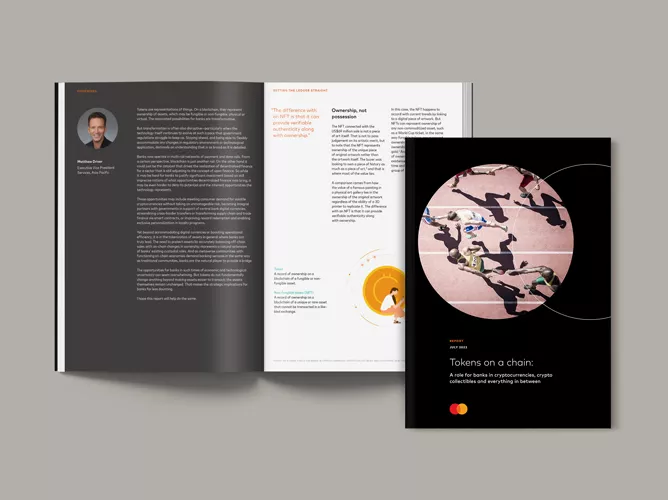July 28, 2023
The distinct words lend and borrow tend to separate what is essentially one concept based on credit. The underlying meaning of credit itself lies in the credibility, or trust, that is shared between a lender and a borrower.
A challenging economic climate can strain that trust.
Credit risk ranked as the top global concern for chief risk officers in banks between 2020 and 2021. Even in 2022, when cyber risk assumed the top spot across financial and non-financial risks, credit risk remained top in Europe and was still the most concerning financial risk globally.1
Lenders lose when their borrowers lose, and the best outcome for borrowers is going to be the best for lenders in the long term too.
Yet most borrowers do not take out a loan without any intent to repay, and most lenders are not predatory loan sharks. Any perception of eroded trust is often just an unfortunate repercussion of unforeseen circumstances. In the end, lenders lose when their borrowers lose, and the best outcome for borrowers is going to be the best for lenders in the long term too.
Achieving that outcome requires answers to challenging questions. For example, when a borrower stops paying their monthly balance in full, does that behavioral shift represent a temporary blip or something more fundamental? At what point should a short-term loan be replaced with a reduced credit limit?
Such questions relate to individual borrower circumstances and dedicated lender responses. Attributes such as “individual” and “dedicated” are important for something as personal as credit and should always be foremost, but a narrow focus can also lead to narrow mindedness. Somewhat counterintuitively, it is breadth that can sharpen financial institutions’ credit risk management by incorporating three overarching perspectives:
An economic upturn is an opportunity for lenders to build trust with their borrowers. It is also often too late.
Loyalty comes from consistency that builds trust in financial institutions. But consistency is challenging enough to maintain during a normal downturn. Throw in some market volatility, and any consistency seems nigh-on impossible.
Short-term approaches, such as rash reductions in credit lines and authorizations across the board or aggressive debt collection, serve neither borrowers’ nor lenders’ best interests. Borrowers who are delinquent through no fault of their own should not be automatically dismissed as a credit risk. It is unfair to them while being detrimental to lenders, who see their long-term brand loyalty suffer.
An economic upturn is an opportunity for lenders to build trust with their borrowers. It is also often too late.
Competition is now rife, and account switching has never been easier. Lenders naturally want to reduce costs and increase productivity, but they do not want to lose borrowers in the process as they scramble to rebuild portfolios during the upturn that inevitably follows.
Although there is no crystal ball that can magically eliminate the analytical cloudiness associated with economic fluctuations, there is a way to couch the variability in a broader context to diffuse its opacity. Even in the best of times, risk is hard to predict when new account values are often not clear until several years out. Accurate segmentation at any point in time comes from efficient automated risk modeling that uses cross-market data across multiple historical starting points within past upturns and downturns.
Instead of shying away from new lending opportunities during a downturn, segmentation based on borrower resilience over extended periods allows for considered approaches to risk management without the impulsivity and severity that can impair a lender’s ability to respond during an upturn. The risk modeling can be further refined based on an optimal tradeoff between accuracy and computing time to meet the needs of instant point-of-sale credit scoring versus more sizeable long-term loans.

A North American bank wants to adopt a less aggressive collection strategy but worries about the potential increase in write-offs of credit card debt. A test-and-learn analysis determines a new collection strategy to grow revenue by 2.1% via increases in interest revenue of 0.98% and fee revenue of 3.1%. However, the growth is offset by a 2.5% increase in expenses that includes a 1.5% increase in write-off rates. Profitability comes from further analyses that highlight which customers will respond best to the new strategy. Annual profits consequently increase by US$15 million.
Another way for lenders to obtain more comprehensive pictures of borrowers beyond short-term economic fluctuations is through alternative credit scoring. Borrowers permit lenders to use their broader financial and other personal data, which can even extend into areas such as behavioral data accumulated over time from mobile phone use. Fintech companies often use such approaches to provide unserved and underserved people with traditional access to credit in an untraditional manner.
A powerful combination for predicting risk comes from layering alternative credit scoring on top of traditional credit scoring. Yet the ability and the inclination to adopt such an approach tends to depend on the types of lenders and their respective markets.
No two markets are the same. Yet with the dynamic economic, social, regulatory and technological challenges of the current environment, even a single market can seem as changeable as the weather.
One relative constant in the turbulence between 2021 and 2022 was global inflation, which increased from 4.7% in 2021 to 8.7% in 2022 and remains high in 2023.2 Higher interest rates then often ensued as governments tried to cool their overheated economies.
Lending banks generally benefit from high interest rates by adjusting the spread in interest they receive on loans versus the amounts they pay out on deposits, but there is a caveat. The higher the rates go, the higher the risk of defaults. Prohibitively expensive loans can then tip an economy into recession as economic activity slows.
Yet a shared global struggle to tame inflation by no means implies a uniformly shared approach to credit across different markets or even geographical regions. A comparison of just two regions, the Asia Pacific and Europe, shows different economic outlooks at the start of 2023 as they both weather the effects of inflation. Comparisons of other regions would likely produce similar findings.
The idea of grappling with the nuances of multiple turbulent markets instead of focusing on one local market might seem at once overwhelming and even irrelevant. But the comparison of financial forecasting with weather forecasting is not an idle one. Particularly during turbulent times, meteorologists cannot solely rely on data from local weather stations any more than banks can make do with data from just their immediate borrowers.
Without any comparable context, it can be difficult to predict the outcome of a tight monetary policy to slow inflation while a tight labor market increases real wages and imbues workers with confidence to reassess their employment status. The reduction in global unemployment rates from 6.9% in 2020 to 6.2% in 2021 is one indicator;3 the rise in inflation in 2022 is another. Who will benefit from wage hikes despite inflation? Who will suffer from the higher prices that result?
The bigger picture provides the essential context. Against this dynamic backdrop, more data on borrower behavior across multiple markets allows for more considered approaches to lending in any particular market. Still, supplementary data must also be comparable data to enable effective segmentation of borrowers. Similar segments across different markets may often serve as better barometers than less similar segments within the same market.
Socio-economic considerations are further affected by regulatory changes and increased scrutiny. Some regulations are international by design, such as the expected credit loss (ECL) requirement of the IFRS 9 international financial reporting standard. Others extend beyond official boundaries, such as strong customer authentication (SCA) to minimize credit card fraud as part of the European Union’s revised Payment Services Directive (PSD2). They all add to the economic dynamism by stimulating different, albeit related, trends across markets.
Access to new technologies adds further dynamism along with aversion to traditional credit. For example, Banking as a Service (BaaS) brings adjustments to the risk–opportunity balance through white-label card issuing that lets sponsoring banks secure additional revenue and fintech partners appeal to new borrowers. Meanwhile, Buy Now, Pay Later (BNPL) is essentially a form of alternative credit that thrives on small purchases and ideally uses customer-permissioned data and open banking technology to reduce the risk of default.

A bank in mainland China needs to meet new regulatory demands to reduce the burden of interest rates on customers paying with installments.4 The bank adopts a four-step approach: analyses of over 25 million cardholders identify five major customer segments and 14 sub segments; testing across branches leads to a comprehensive pricing strategy; benchmarking of over 30 issuing banks allows an assessment of system readiness; scanning balance transfers across nine markets identifies various entry strategies with profit-and-loss forecasts. The result is a 19% lift in revenue from installments worth US$45 million.
The incorporation of dynamic socio-economic, regulatory and technological considerations across markets takes much of the guessing game out of credit risk management. But they cannot fundamentally transform credit, with its susceptibility to economic forces and borrower proclivities, into a fixed product. Any successful risk management during turbulent times requires a focus on long-term economic fluctuations over short-term global snapshots. It also requires a self-awareness on the part of lenders on how their backgrounds and roles differ.
Once upon a time, all official lending institutions were community banks. Mergers and acquisitions then resulted in big banks with wider product selections and different revenue models. Digital-only “neobanks” recently put some focus back on niche products, but their communities are defined by specific needs online rather than by physical locations offline.
The three models—community bank, big bank, neobank—all require different approaches to credit risk.
When a community bank issues a loan, the borrower is often already known to the bank to a degree. Community banks cannot avoid unintentional subjectiveness or human inefficiency relative to automated data-crunching, nor do they disregard industry trends, but local knowledge can sometimes provide insights into borrowers’ circumstances that are unavailable from faceless financial data. Long-term cross-market data can then supplement any shortfalls in internal data to answer such questions as whether variable-rate interest might serve some borrowers better than fixed-rate interest while helping lenders with liquidity.
Community bank, big bank, neobank—all require different approaches to credit risk.
Where community banks may be stifled by a lack of comparable data, big banks may sometimes be stifled by an overwhelming mass of data. In theory, more data means better outputs. But the quality of the data, which should include long-term cross-market data from outside the bank, is the real differentiator in practice.

A sub-Saharan bank with operations across Africa wants to expand the use of its credit cards across five key markets. However, its credit risk management is not aligned with the needs of the local customers. A cross-market analysis of credit scoring and underwriting, including strategies for credit line management and collections, results in an application risk scorecard and regional guidebooks on underwriting and credit risk policy. The bank successfully applies the tools to boost customers’ credit worthiness in the local markets.
Big banks do not have the luxury of “knowing” many of their customers like community banks, but they do have the luxury of being able to conduct repeat testing of approaches in their multiple markets.
The idea that an algorithm may know someone better than they know themselves can sometimes ring true when creating lending models based on similar borrower segments. Local testing against controls can tease out errors in forecasts before committing more broadly, and the adjusted inputs can then refine future forecasts. The amount of refinement varies based on budgets as returns on investment tend to diminish with each test.
The notion of a big bank with lots of resources but limited digital nous contrasts with the notion of a neobank with limited resources but lots of digital nous. However true that stereotype once was, the reality today is that digitalization is commonplace, and data access is increasingly equitable through partnerships and open banking. The expansion of neobanks beyond niche offerings also serves up more data while allowing for lower costs of credit as revenues diversify.
Yet as neobanks expand their reach and by extension their resources, licensing questions arise. Many neobanks do not have their own licenses and instead rely on other banks’ licenses through Banking as a Service. Although credit risk and underwriting responsibilities remain with the licensed banks, brand reputation mostly lies with the neobanks who still need to manage risk regardless of ultimate liability. Some neobanks secure their own licenses to avoid sharing revenue with licensors, but the need for substantial upfront and ongoing investment makes that the preserve of only the largest.
Credit risk is not just the preeminent financial risk. Even if all other financial risks, such as market risks or regulatory implementation risks, were to hypothetically align with the economic or regulatory environments, credit risk would persist as something subject to borrowers’ independent ails and whims.
A variety of tools can help lenders manage credit risk holistically:
- Diagnostic tools for credit risk and credit underwriting to identify credit risk management gaps and prioritize enhancement opportunities.
- Strategic approaches for credit underwriting, authorizations, credit line management, collections, and risk-based pricing to meet business objectives.
- Analytical tools for underwriting scoring, transaction-based risk scoring and for incorporating open banking data to boost efficiency.
- Measurement tools to quantify and compare the impacts of enhancements and then recalibrate based on learnings.
The effectiveness of the tools depends on self-aware lenders accessing dynamic global data that incorporates long-term economic upturns and downturns. Yet the success built with the tools is not based on the impossible aim of complete control. Rather it is based on the trust encapsulated in the concept of credit. A trust that reassures a lender and a borrower that they are entering into a credit relationship under the best possible terms for them both.
Speak with an expert to learn more.
2 “World Economic Outlook: Countering the cost-of-living crisis” and “World economic outlook update: Inflation peaking amid low growth.” International Monetary Fund, October 2022 and April 2023.
3 ILO Modelled Estimates from the ILOEST database of the United Nations International Labour Organization (ILO).
4 关于进一步促进信用卡业务规范健康发展的通知 (“Notice on further promoting the standardized and healthy development of credit card business”). China Banking and Insurance Regulatory Commission (CBIRC) & People's Bank of China (PBC), 7 July 2022.




















